The MyDigitalSSD SBX SSD Review: NVMe On The Cheap
by Billy Tallis on May 1, 2018 8:05 AM ESTRandom Read Performance
Our first test of random read performance uses very short bursts of operations issued one at a time with no queuing. The drives are given enough idle time between bursts to yield an overall duty cycle of 20%, so thermal throttling is impossible. Each burst consists of a total of 32MB of 4kB random reads, from a 16GB span of the disk. The total data read is 1GB.

The QD1 burst random read performance of the MyDigitalSSD SBX is relatively poor, falling behind the top tier of SATA SSDs. The SBX is faster than the Intel SSD 600p, but the newer Intel 760p is more than 50% faster than the SBX.
Our sustained random read performance is similar to the random read test from our 2015 test suite: queue depths from 1 to 32 are tested, and the average performance and power efficiency across QD1, QD2 and QD4 are reported as the primary scores. Each queue depth is tested for one minute or 32GB of data transferred, whichever is shorter. After each queue depth is tested, the drive is given up to one minute to cool off so that the higher queue depths are unlikely to be affected by accumulated heat build-up. The individual read operations are again 4kB, and cover a 64GB span of the drive.
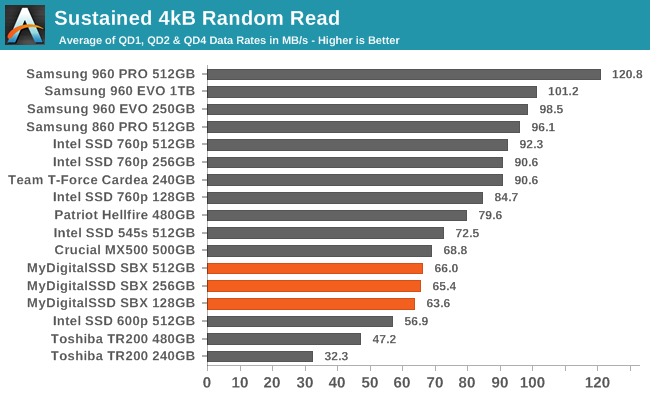
The ranking of the MyDigitalSSD SBX doesn't change much on the longer random read test, but many of the faster drives have traded places. Even with some higher queue depths involved, the SBX can't quite match the best SATA SSDs for random read performance.
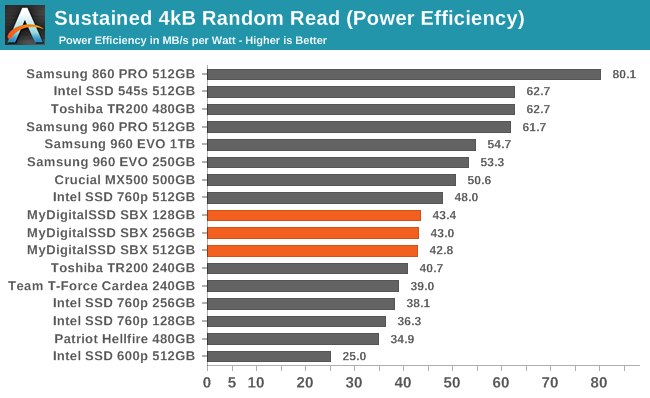 |
|||||||||
| Power Efficiency in MB/s/W | Average Power in W | ||||||||
The MyDigitalSSD SBX draws substantially less power during the random read test than most NVMe SSDs, which leads to an efficiency score that is about average. Many of the SATA drives have a significant efficiency advantage, as do several of the fastest NVMe SSDs.
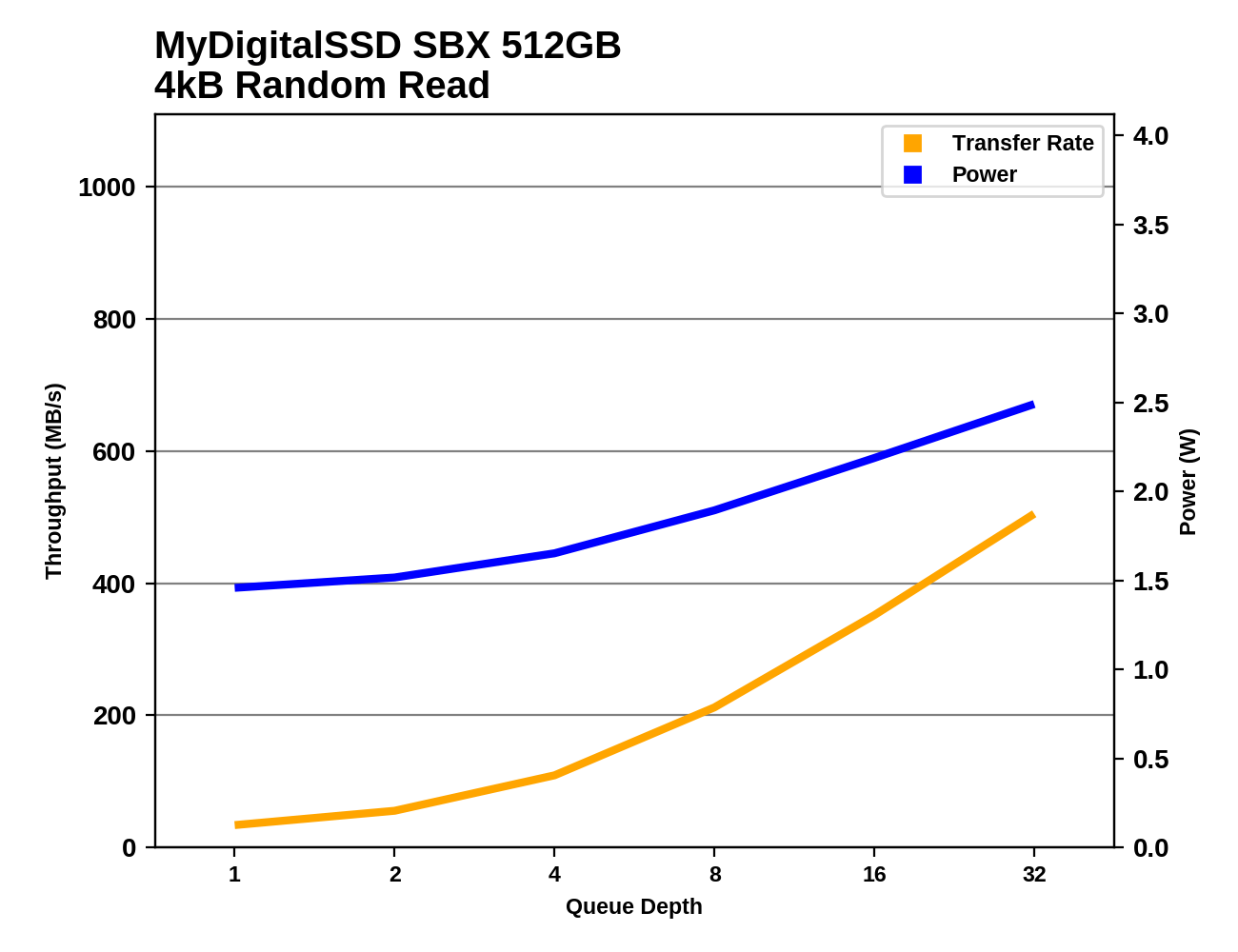 |
|||||||||
The 512GB SBX clearly has room for further throughput increases past QD32, but the smaller capacities start falling behind past QD4 and are close to saturation by QD32. The Intel SSD 760p shows similar performance scaling that is almost always a bit faster than the SBX, but also requires significantly more power across the board.
Random Write Performance
Our test of random write burst performance is structured similarly to the random read burst test, but each burst is only 4MB and the total test length is 128MB. The 4kB random write operations are distributed over a 16GB span of the drive, and the operations are issued one at a time with no queuing.
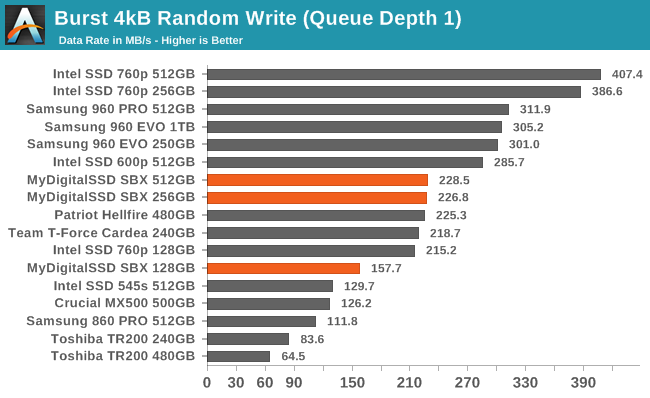
The burst random write performance of the MyDigitalSSD SBX can't match the unusually good performance from the Intel SSD 760p, but it is certainly reasonable for a low-end NVMe SSD. The 128GB SBX is about 30% slower than the larger capacities, but is still faster than the SATA drives.
As with the sustained random read test, our sustained 4kB random write test runs for up to one minute or 32GB per queue depth, covering a 64GB span of the drive and giving the drive up to 1 minute of idle time between queue depths to allow for write caches to be flushed and for the drive to cool down.
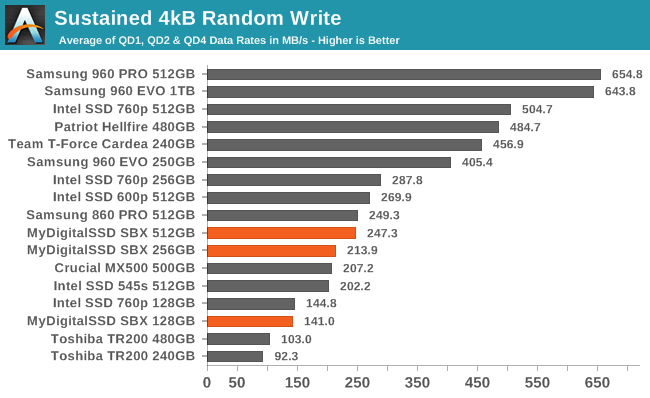
On the longer random write test, SLC cache size limitations come into play and the 128GB drives end up near the bottom of the chart, above only the DRAMless SATA drives. The larger capacities aren't quite as fast as the top SATA SSDs, and the more expensive NVMe SSDs offer more than double the throughput of the SBX even at these relatively low queue depths.
 |
|||||||||
| Power Efficiency in MB/s/W | Average Power in W | ||||||||
The SBX is again using much less power than the other NVMe SSDs, but its poor performance leaves it with a fairly low efficiency score.
 |
|||||||||
Performance from the SBX drops during the early phases of the random write test as the SLC write cache is quickly filled. Only the 512GB model manages to recover performance later at high queue depths, but its eventual limit is not far above the performance offered by SATA drives.










46 Comments
View All Comments
MajGenRelativity - Tuesday, May 1, 2018 - link
The price premium of lower-end NVMe SSDs forms a big part of their problem in my head. When I build a computer for somebody, I usually use an M.2 SATA SSD if I include an SSD, because SATA SSDs are the cheaper alternative, and most people won't use the performance of an NVMe SSD. If they *do* need the performance of NVMe, I find it a little hard to justify stopping at the low end when they can pay a bit more and bump up the performance by quite a lot. My thoughts are that while products like the SBX are a step in the right direction, they really need to match SATA drives in price to become fully worthwhile.Dribble - Tuesday, May 1, 2018 - link
The other thing they have going for them is size. I can see a cheap nvme being used quite a bit in mid range laptops that came with a SATA disk but have a spare nvme slot. For desktops not only does the drive sit flush with the motherboard mostly, but it requires no cabling and no hd cage to put it in. I could see myself getting one as a second drive - it's not like I'd really be able to tell it's any slower then a high end drive for standard desktop usage.Dribble - Tuesday, May 1, 2018 - link
Ah didn't read the previous comment carefully enough "M2 SATA SSD" not "SATA SSD", never mind.MajGenRelativity - Tuesday, May 1, 2018 - link
Yeah. I can see 2.5" SATA going away entirely / being replaced by 2.5" U.2, but M.2 SATA still has a place for meeek2121 - Wednesday, May 2, 2018 - link
My current machine no longer has any type of SATA drive in it. I have a single 1TB Samsung 960 EVO. I thought about going going for the pro or a 2 TB EVO, but this fits my needs perfectly. Now if we could just get a mini-itx threadripper board... ;)MajGenRelativity - Thursday, May 3, 2018 - link
For me, I need bulk storage, so SATA isn't going away any time soon. However, I don't think Mini-ITX Threadripper will happen, as the socket is too bigRatman6161 - Monday, May 7, 2018 - link
Price wise, for a lot of people in your situation, you could get the 500 GB 960 EVO for $200 and also the 1 TB MX500 for $249. That would give you a total of 1.5 TB for the price of a 1 TB 960EVO. Then EVO could then be used for OS and programs with some data while the cheap but still pretty good MX500 could provide the big storage.gglaw - Saturday, May 19, 2018 - link
The popular budget Micron 3D TLC 2TB drives are on sale all the time from $280-$300 range. They don't have much marketing or even a fancy name associated with them, come in a bare OEM type box but the few reviews out are all favorable. I have one as a secondary storage drive with a 960 EVO 500GB boot drive but tbh when I moved my Steam library over to it, I can't even tell the difference in performance between it and the NVMe EVO.https://www.amazon.com/Micron-1100-SATA-2-5-inch-M...
that's the drive but it goes on sale lower than that pretty much every week.
wumpus - Tuesday, May 1, 2018 - link
Why eat the slot? Do your clients get grumpy if they see and "old fashioned" 2.5" drive? I'd rather leave the M.2 slot waiting for a card that really needs it, and still have the SATA drive connected.MajGenRelativity - Tuesday, May 1, 2018 - link
I sell to a variety of clients (I co-own a small business so we cover all sorts), and usually they don't have enough technical knowledge to know the difference between a 2.5" drive and M.2. I use the M.2 slot because it allows me to either disconnect the SATA cable (for a modular PSU), or tuck it out of the way to increase airflow. Most of my customers won't need the performance boost of upgrading to an NVMe drive, so it hasn't been a problem before. In the cases where that is a viable upgrade path, I discuss it ahead of time, and do use a 2.5" drive in situations where necessary/desired.